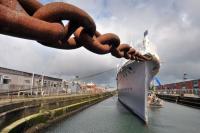 HMS Caroline, a decommissioned Royal Navy C-class light cruiser, is the last survivor of the Battle of Jutland, and one of only three surviving Royal Navy warships of the First World War. Now in Belfast, she has undergone a many million pound renovation and restoration to reflect her condition in 1916, when she served with the Grand Fleet in the Battle of Jutland, May 31 – June 1, 1916. Appropriately, she will be opening to the public as a museum ship and interpretive center on June 1st.
HMS Caroline, a decommissioned Royal Navy C-class light cruiser, is the last survivor of the Battle of Jutland, and one of only three surviving Royal Navy warships of the First World War. Now in Belfast, she has undergone a many million pound renovation and restoration to reflect her condition in 1916, when she served with the Grand Fleet in the Battle of Jutland, May 31 – June 1, 1916. Appropriately, she will be opening to the public as a museum ship and interpretive center on June 1st.
The renovation has included the installation of replica six-inch guns and torpedoes
As reported by Belfast Live: The level of detail in bringing the vessel back to life includes using ‘Jutland grey’ paint that was uncovered as renovation began and recreated to paint the 100-year-old ship. Around 40 carpenters are working flat-out to fit the deck with thick flooring made from a tropical hardwood called iroko.
There are officers’ quarters, a captain’s quarters and a mess hall for the Royal Marines that served on board. As well as the authentic features that anyone onboard in 1916 would have seen, there will be 21st century technology including interactive guides as well as a room where younger visitors can do things like designing their own ‘dazzle camouflage’.
National Museum of the Royal Navy Chief of Staff Captain John Rees OBE says, “HMS Caroline is a living legend. We are breathing new life into what is an internationally significant piece of world history. We are particularly looking forward to the ship being ready for public opening on June 1, 2016. This will mark the first stage of a series of phased openings. The second and third phases will see the ship dry docked for hull conservation works in the winter and then the completion of onshore facilities.”
HMS Caroline and maritime history
Thanks to David Rye for contributing to this post.

I’m surprised at the choice of iroko, it has proved to be a costly mistake for HMS Victory and in my own experience has not performed well except for interior work. I doubt the decks were originally iroko, more likely teak if a far eastern hardwood at all. In those days the navy would more likely have used baltic pine or possibly Douglas fir. For a ship expecting a heavy visitor footfall my preference would have been Doug fir pressure treated with vinegar.
The decking choice was really a “windfall”, because a cargo was impounded at Belfast Harbour by HMRC. The authorities then passed it gratis to the project, saving a ton of money.